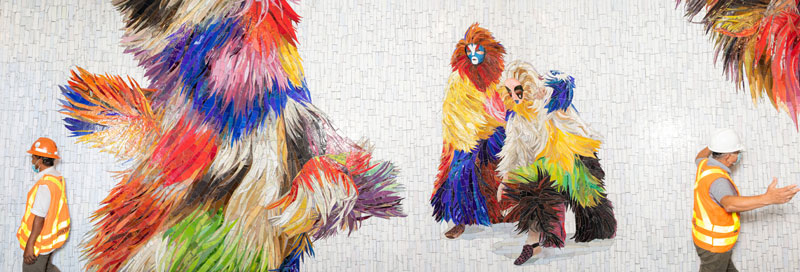
It’s hard to tell how long Nick Cave has been turning things people throw away into spectacular works of art. He says he started when he was kid growing up in tiny Fulton, Missouri where his family actively encouraged him to explore the contours of his imagination. Now, several decades later, Cave still uses the random things people discard, in addition to objects he finds in nature, as his raw material for his creations. In our current moment in time though, he’s celebrated throughout the world for the way he expresses his artistic vision. Taking the form of elaborate art installations, bold sculptural compositions and fantastical textile representations, his art is rarely subtle. Instead, it’s often bright, large, emphatic and filled with so much detail that close inspection is the only way to fully absorb it.
Since May, Chicagoans have been thronging to Cave’s Forothermore exhibit at the Museum of Contemporary Art. The show will be closing October 2nd in preparation for a similar stint at the Guggenheim in New York. From the moment you land on the museum’s fourth floor, astonishment is the inevitable first reaction. Audacity, extravagant color, singular imagination and mass come together to create an unexpected sensory explosion that feels confident and powerful. It’s a sensation that fills the exhibit’s galleries. The same attributes help to explain the swarms of people attending Forothermore and the impressive range in their ages and backgrounds.

Cave works in a wide range of formats and most of them carry a sculptural component. Some might focus on textiles, others use wood or plastic or metal as the material that gives a piece its “pulse”. It’s very common for the artist to use these materials in combination to give a piece its final identity. The variety of mediums and approaches Cave applies to his works affords him range. It’s sometimes even possible to detect the seminal origins of their inspiration. Strolling from gallery to gallery, it’s surprising that the same artist created so much diversity in his artistic translations of the world.
His Spinner Forest, the beautiful and outrageously ambitious installation that welcomes visitors to the exhibit, initially dazzles and then dumbfounds. Made up of thousands of colorful metallic spinners, the piece is like a gigantic engulfing mobile that’s been stolen from a technicolor dream. That kind of reaction is what Cave hopes to inspire. As he’s stated in interviews, he wants people to “release a different kind of consciousness” and be “set back to a dream state”. That doesn’t mean the works he produces can’t tie back to concrete perceptions linked to real world concerns.

Like Andy Warhol’s paintings of soup cans all but define his impact on modern art, Cave’s international renown stems from his Soundsuits, or what the artist refers to as his figurative sculpture works. They go back to 1992 and Cave’s reaction to the Rodney King beating in LA. As a Black man, the incident made him reflective and question how he should view King’s assault in the context of his own life. Relying solely as he does on found objects to feed his muse, Cave never draws or pens sketches for any of his conceptions. His first Soundsuit started with the discovery of a twig. When he found it in a park, he had no idea what he would do with it; which didn’t discourage him from collecting more and more of them. When the shell he eventually constructed with the twigs began to take shape, he discovered he could stand inside it. Then his mind started turning over ideas of power, identity and survival. The Soundsuit was born from those ruminations, an all-encompassing sculptural costume that envelopes the person inside and makes sounds as it moves. As the artist points out, once you’re encased inside, you lose all external signifiers. Race, gender, age and class all disappear. Now over twenty years and 500 Soundsuits later, they’re still thrilling people all over the world. In May, colossal mosaics featuring Cave’s Soundsuits were installed in the New York’s Times Square subway station.

The Soundsuits and installations like the Spinning Forest highlight the otherworldly dimension of Cave’s art. It’s art that makes the inconceivable tangible. But his subjects can also take on personal, highly relatable themes. Time and Again, a mixed media work he completed in 2000 was created shortly after his grandfather’s death. Simple, organized and pure, the artist brought together items that served two purposes. They represented his rural upbringing and symbolized aspects of his grandfather’s life. One side is saturated with crucifixes, empty spools, harnesses and farming implements while the other simply features a wooden chair with a small plastic pig standing on the chair’s seat. The longer you linger and allow your eyes to roam through its barrage of symbols, the more moving the piece becomes.
Cave also takes his observations and turns them into visual commentary. It can be in the way he shows how the penchant for bling penetrates every stratum of society; or how he displays the ease in which the religious and the pagan can shape our actions. Regardless of the medium he chooses to express his message, they seem to be as intellectually arresting as they are visually beautiful.
Retrospectives give clues to where artists may be going as well as provide a review of what they’ve done. It’s the kind of brilliance displayed in Forothermore that whets your appetite for new work from artists like Nick Cave.
Forothermore
Through October 2, 2022
Museum of Contemporary Art
220 East Chicago
Chicago, IL 60611